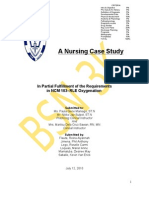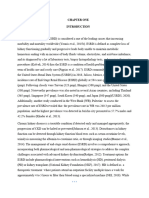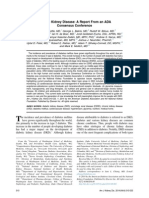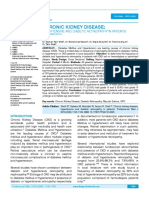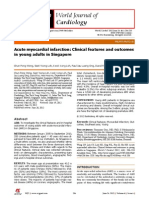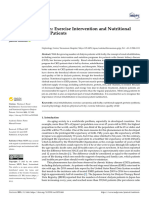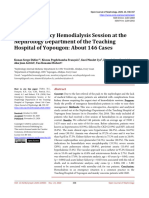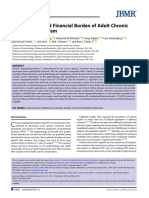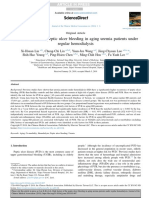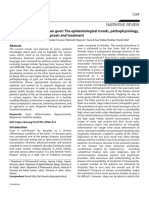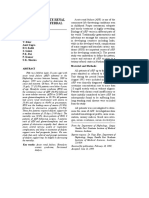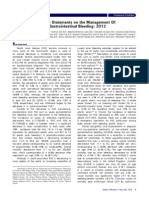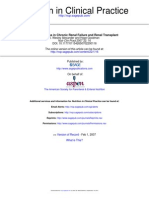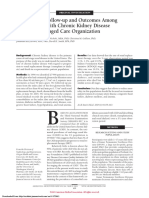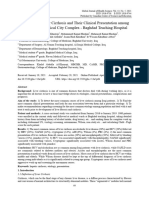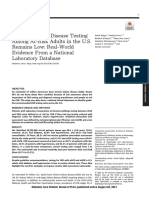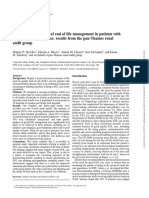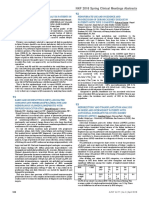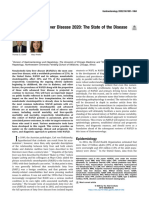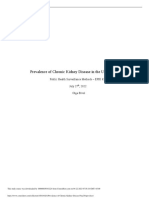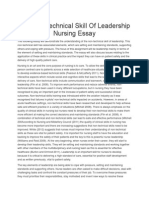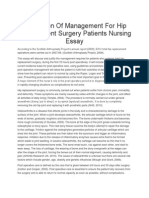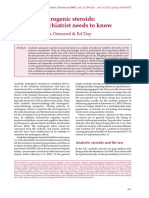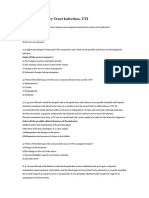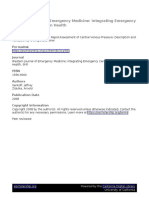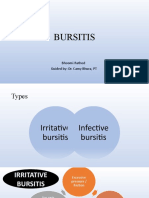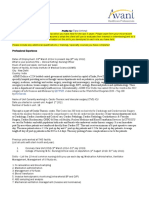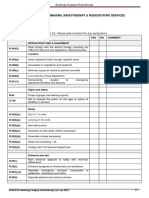PD Program Was Successful in Hong Kong
PD Program Was Successful in Hong Kong
Uploaded by
NavinYattiCopyright:
Available Formats
PD Program Was Successful in Hong Kong
PD Program Was Successful in Hong Kong
Uploaded by
NavinYattiOriginal Description:
Copyright
Available Formats
Share this document
Did you find this document useful?
Is this content inappropriate?
Copyright:
Available Formats
PD Program Was Successful in Hong Kong
PD Program Was Successful in Hong Kong
Uploaded by
NavinYattiCopyright:
Available Formats
PD program was successful in Hong
Kong
Introduction
History of present illness
Mr. Wong was a 46-year old man. He defaulted current follow up and 2 days continuous ambulatory
peritoneal dialysis (CAPD). On admission, his blood pressure (BP) was 197/106mmHg, pulse was
108/min, oxygen saturation was 94% in room air, body temperature was 36.5 degree Celsius, body
height was 1.78 m, and body weight was 82.3 kg (body mass index was 26.0kg/m2). Glasgow Coma
Scale (GCS) was E4; V5; M6 (E4: Open eyes spontaneously; V5: Oriented, converses normally; M6:
Obey commands). His chief complaints were fatigue, shortness of breath, dyspnea on exertion at
this admission.
From this preliminary data, the following literature review and nursing assessment was trying to
understand anemia in CAPD client.
Literature review
Demographics of the end-stage renal disease
population
The World Health Organization (WHO) had already recognized that renal disease was a public
health issue. In 2000, there were about 1.5 million patients globally on dialysis; in 2010, this number
was projected to increase to 2.5 million, a 7% increase year on year. A similar trend was being
observed in Hong Kong. The incidence of end-stage renal failure (ESRF) requiring replacement
therapy had increased significantly around the world. Data from the United States Renal Data
System (USRDS) for the year 2005 showed that Taiwan had an annual incidence of 404 new cases
per million population (pmp), the highest in the world. In Hong Kong, the annual incidence was 173
new cases pmp in 2005, taking the 13th place in the USRDS data. The prevalence was 965 uremic
patients pmp requiring treatment in Hong Kong in 2005. For the age group of 2044, Hong Kong
ranked number 4 with 88 new cases pmp. For the age group of 4564, Hong Kong ranked number 5
with 289 new cases pmp (USRDS, 2007). This signified that renal disease was common in our
relatively younger population. Prevalence and incidence in 2007 were respectively 1026 and 164
pmp according to the Hong Kong Renal
Registry
. Prevailing causes of chronic kidney disease (CKD) in Hong Kong were diabetes (23%),
glomerulonephritis (GN, 34%) and hypertension (7%) for existing renal replacement therapy
(RRT) patients surveyed in 2007 (Lam, 2009). This had prompted the development of strategies
aimed at preventing the development and progression of asymptomatic CKD. Rising demand for
dialysis therapy and its associated costs were placing an unsustainable financial burden on public
sector health care budgets in countries all over the world, which carried profound implications
for health care financing in the near future. The predicted dialysis cost globally would increase to
about US$1.1 trillion for the decade of 20012010, compared with about US$500 billion spent
for the last decade worldwide. An ideal renal replacement therapy should have optimal survival,
lowest possible risk for comorbidity, highest level of quality of life and, equally important,
acceptable cost for society. Viable solutions were urgently needed in managing the treatment of
end-stage renal disease (ESRD) and controlling spending on ESRD without compromising the
quality of patient care. The policy model used in Hong Kong was using CAPD first, was also
being considered by other countries as an appealing cost-effective modality. The overall survival
of peritoneal dialysis (PD) patients in PWH was very respectable, with a 2-year patient survival
of 91% and technique survival of 82%. With an increasing number of elderly ESRD patients, the
2-year and 5- year patient survival rates for the elderly group in PD program were 89.3% and
54.8%, respectively, which were comparable to the rate of survival in the non-elderly group.
There were good reasons for why the PD program was successful in Hong Kong (Li, 2008).
You might also like
- Personal Reflection On Practicing A Clinical Skill Nursing EssayDocument2 pagesPersonal Reflection On Practicing A Clinical Skill Nursing EssayNavinYatti100% (4)
- Practice Bulletin: Management of Preterm LaborDocument10 pagesPractice Bulletin: Management of Preterm LaborXimena OrtegaNo ratings yet
- A Case Study On Chronic Kidney DiseaseDocument103 pagesA Case Study On Chronic Kidney DiseaseLouella Mae CoraldeNo ratings yet
- Case Study On Chronic Kidney DiseaseDocument101 pagesCase Study On Chronic Kidney DiseaseZNEROL100% (7)
- Reflection Has Become An Important Concept in Nursing Nursing EssayDocument3 pagesReflection Has Become An Important Concept in Nursing Nursing EssayNavinYatti100% (1)
- Case Study of An Ethical DilemmaDocument3 pagesCase Study of An Ethical DilemmaNavinYatti0% (1)
- 11 Going To The DentistDocument7 pages11 Going To The DentistElizabeth UrbinaNo ratings yet
- STD Risk Assessment QuestionnaireDocument1 pageSTD Risk Assessment QuestionnaireTine GuibaoNo ratings yet
- Literature Review Demographics of The End-Stage Renal Disease PopulationDocument22 pagesLiterature Review Demographics of The End-Stage Renal Disease PopulationSriMathi Kasi Malini ArmugamNo ratings yet
- Chapter OneDocument11 pagesChapter OneAhmed - SawalhaNo ratings yet
- Dialysis in Malaysia: EditorialDocument3 pagesDialysis in Malaysia: EditorialfisplNo ratings yet
- Ing GrisDocument2 pagesIng Grisvia lattansaNo ratings yet
- Am J Kidney Dis 2014 Oct 64 (4) 510Document24 pagesAm J Kidney Dis 2014 Oct 64 (4) 510hrol31060No ratings yet
- Structure of Urinary TractDocument52 pagesStructure of Urinary TractAhmed Naguib MohamedNo ratings yet
- Chronic Kidney Disease : Hypertensive and Diabetic Retinopathy in PatientsDocument7 pagesChronic Kidney Disease : Hypertensive and Diabetic Retinopathy in PatientsAnonymous FgT04krgymNo ratings yet
- Chronic Kidney Disease: PathophysiologyDocument11 pagesChronic Kidney Disease: Pathophysiologymiguel_81908No ratings yet
- Prevalence of Chronic Kidney Disease in Nigeria Systematic - 052118Document8 pagesPrevalence of Chronic Kidney Disease in Nigeria Systematic - 052118Zainab Abubakar GwanduNo ratings yet
- P ('t':'3', 'I':'668014889') D '' Var B Location Settimeout (Function ( If (Typeof Window - Iframe 'Undefined') ( B.href B.href ) ), 15000)Document5 pagesP ('t':'3', 'I':'668014889') D '' Var B Location Settimeout (Function ( If (Typeof Window - Iframe 'Undefined') ( B.href B.href ) ), 15000)Ambar RahmanNo ratings yet
- Update On The Burden of CKD: PerspectivesDocument3 pagesUpdate On The Burden of CKD: Perspectiveskainputih351513No ratings yet
- Nutrients 13 01444Document15 pagesNutrients 13 01444putraNo ratings yet
- Sirosis Dan ESRDDocument9 pagesSirosis Dan ESRDdevidanthonyNo ratings yet
- Anemia Pxs en HemodialisisDocument12 pagesAnemia Pxs en HemodialisisPedrob456No ratings yet
- The Impact of Chronic Kidney Disease On Developed Countries From A Health Economics Perspective: A Systematic Scoping ReviewDocument19 pagesThe Impact of Chronic Kidney Disease On Developed Countries From A Health Economics Perspective: A Systematic Scoping ReviewWalter Espriella CastellarNo ratings yet
- Urgencias en Dialisis 3Document10 pagesUrgencias en Dialisis 3Leyla AbdalahNo ratings yet
- JBMR 37 2602Document13 pagesJBMR 37 2602Juanjo Moreno LópezNo ratings yet
- S2.0-S1726490118300984-MainDocument6 pagesS2.0-S1726490118300984-MainVictorson Leonardo ZegaNo ratings yet
- Epidemiologi GGKDocument10 pagesEpidemiologi GGKOctavianus KevinNo ratings yet
- SGD 3Document5 pagesSGD 3Nanda SapitriNo ratings yet
- 1 s2.0 S1051227616301789 MainDocument7 pages1 s2.0 S1051227616301789 MainResearch OfficeNo ratings yet
- Reviews: Nephrology in ChinaDocument6 pagesReviews: Nephrology in ChinaAshan HasanthaNo ratings yet
- A Study To Assess Changes in The Hematological Profile in Chronic Kidney DiseaseDocument3 pagesA Study To Assess Changes in The Hematological Profile in Chronic Kidney Diseasemandhalanarshimlu48141No ratings yet
- Global Prevalence of Chronic Kidney Disease - A Systematic Review and Meta-AnalysisDocument18 pagesGlobal Prevalence of Chronic Kidney Disease - A Systematic Review and Meta-AnalysisMellya RizkiNo ratings yet
- Prevalence of Chronic Kidney Disease in China - A Cross-Sectional SurveyDocument3 pagesPrevalence of Chronic Kidney Disease in China - A Cross-Sectional SurveyfycheeseNo ratings yet
- Biopsias RenalesDocument22 pagesBiopsias RenalesmarurestrepoNo ratings yet
- The Impact of Malnutritional Status On Survival in Elderly Hemodialysis PatientsDocument5 pagesThe Impact of Malnutritional Status On Survival in Elderly Hemodialysis PatientsTika MahelsaNo ratings yet
- International Incidence and Mortality Trends of Liver Cancer: A Global ProfileDocument9 pagesInternational Incidence and Mortality Trends of Liver Cancer: A Global ProfileNovita ApramadhaNo ratings yet
- Interoduction CRPDocument8 pagesInteroduction CRPsalons.errands0hNo ratings yet
- Impact of Maintenance-1704Document20 pagesImpact of Maintenance-1704hanady shehataNo ratings yet
- BMC Nephrology: Risk Factors For Chronic Kidney Disease in Japan: A Community-Based StudyDocument10 pagesBMC Nephrology: Risk Factors For Chronic Kidney Disease in Japan: A Community-Based StudyYudaAmanikoNo ratings yet
- Pattern of Acute Renal Failure at A Referral HospitalDocument7 pagesPattern of Acute Renal Failure at A Referral HospitalminhajulqowimNo ratings yet
- Anemia in CKD Patient On HeamodialysisDocument32 pagesAnemia in CKD Patient On HeamodialysisEditor IJTSRDNo ratings yet
- Chronic Kidney DiseaseDocument283 pagesChronic Kidney DiseaseloisebadNo ratings yet
- Prevalence of Anemia in Chronic Kidney Disease in The United StatesDocument5 pagesPrevalence of Anemia in Chronic Kidney Disease in The United StateslionfairwayNo ratings yet
- Philippine Consensus Statements On The Management of Non-Variceal Upper Gastrointestinal Bleeding 2012Document13 pagesPhilippine Consensus Statements On The Management of Non-Variceal Upper Gastrointestinal Bleeding 2012Danica Nicole Seco Gabon100% (1)
- Nutrition in Clinical Practice: Gastric Bypass in Chronic Renal Failure and Renal TransplantDocument7 pagesNutrition in Clinical Practice: Gastric Bypass in Chronic Renal Failure and Renal Transplantfakeemail168No ratings yet
- Sceintific Writing 1Document5 pagesSceintific Writing 1ibrahimNo ratings yet
- Seminar: Kamyar Kalantar-Zadeh, Tazeen H Jafar, Dorothea Nitsch, Brendon L Neuen, Vlado PerkovicDocument17 pagesSeminar: Kamyar Kalantar-Zadeh, Tazeen H Jafar, Dorothea Nitsch, Brendon L Neuen, Vlado PerkovicJack JackNo ratings yet
- Comparison The Effect of High Flux and Low Flux Dialyzer On Quality of Life in Hemodialysis Patients A Clinical TrialDocument8 pagesComparison The Effect of High Flux and Low Flux Dialyzer On Quality of Life in Hemodialysis Patients A Clinical TrialMrQmonkNo ratings yet
- Longitudinal Follow-Up and Outcomes Among A Population With Chronic Kidney Disease in A Large Managed Care OrganizationDocument5 pagesLongitudinal Follow-Up and Outcomes Among A Population With Chronic Kidney Disease in A Large Managed Care OrganizationMonica PutriNo ratings yet
- Prevalence of Atherosclerosis-Related Risk Factors and Diseases in The PhilippinesDocument8 pagesPrevalence of Atherosclerosis-Related Risk Factors and Diseases in The PhilippinesTricia LlorinNo ratings yet
- Etiologies of Liver Cirrhosis and Their Clinical Presentation Among Inpatients in Medical City Complex - Baghdad Teaching HospitalDocument17 pagesEtiologies of Liver Cirrhosis and Their Clinical Presentation Among Inpatients in Medical City Complex - Baghdad Teaching HospitaljmclaverNo ratings yet
- Modern Management of Pyogenic Hepatic Abscess: A Case Series and Review of The LiteratureDocument8 pagesModern Management of Pyogenic Hepatic Abscess: A Case Series and Review of The LiteratureAstari Pratiwi NuhrintamaNo ratings yet
- Chronic Kidney Disease in Children and AdolescentsDocument16 pagesChronic Kidney Disease in Children and AdolescentsFernanda SierraNo ratings yet
- AASLD Guidelines NAFLDDocument19 pagesAASLD Guidelines NAFLDcommiekapurNo ratings yet
- Tatalaksana Abses HeparDocument6 pagesTatalaksana Abses HeparAdhi Rizky PutraNo ratings yet
- Diabcare 2021 Rwe CKDDocument8 pagesDiabcare 2021 Rwe CKDanderson roberto oliveira de sousaNo ratings yet
- Jurnal Kedokteran Dan Kesehatan Indonesia: Global Challenge of Early Detection and Management of Chronic Kidney DiseaseDocument2 pagesJurnal Kedokteran Dan Kesehatan Indonesia: Global Challenge of Early Detection and Management of Chronic Kidney DiseaseValencia JaneNo ratings yet
- gfr514 PDFDocument7 pagesgfr514 PDFnita noviantariNo ratings yet
- Upper Gi BLDocument4 pagesUpper Gi BLCristina DraghiciNo ratings yet
- 10 1053@j Ajkd 2018 02 096Document1 page10 1053@j Ajkd 2018 02 096Yunita AmiliaNo ratings yet
- Ijcem0008 9830Document9 pagesIjcem0008 9830Ocha24 TupamahuNo ratings yet
- Nonalcoholic Fatty Liver Disease 2020 The State of The DiseaseDocument14 pagesNonalcoholic Fatty Liver Disease 2020 The State of The Diseasedr.pujasinghNo ratings yet
- Clinical Outcome of Donors PDFDocument7 pagesClinical Outcome of Donors PDFEngidaNo ratings yet
- Prevalence of Chronic Kidney Disease Final PaperDocument8 pagesPrevalence of Chronic Kidney Disease Final PaperDamie OjoNo ratings yet
- Acute Kidney Injury in COVIDDocument16 pagesAcute Kidney Injury in COVIDYUSUF MUSANo ratings yet
- Complementary and Alternative Medical Lab Testing Part 8: UrologyFrom EverandComplementary and Alternative Medical Lab Testing Part 8: UrologyRating: 3 out of 5 stars3/5 (1)
- SQL - CH 12 - Creating A DatabaseDocument9 pagesSQL - CH 12 - Creating A DatabaseNavinYattiNo ratings yet
- The Non Technical Skill of Leadership Nursing EssayDocument3 pagesThe Non Technical Skill of Leadership Nursing EssayNavinYattiNo ratings yet
- The Prohibition of Euthanasia Nursing EssayDocument2 pagesThe Prohibition of Euthanasia Nursing EssayNavinYattiNo ratings yet
- Study Effectiveness of Nebulization Improving Childrens Respiratory Status Nursing EssayDocument2 pagesStudy Effectiveness of Nebulization Improving Childrens Respiratory Status Nursing EssayNavinYattiNo ratings yet
- Sample Coursework: (1) What Is Plagiarism?Document2 pagesSample Coursework: (1) What Is Plagiarism?NavinYattiNo ratings yet
- Meetings With Project MentorDocument3 pagesMeetings With Project MentorNavinYattiNo ratings yet
- Journey Through Criminal Justice Systems Law EssayDocument2 pagesJourney Through Criminal Justice Systems Law EssayNavinYattiNo ratings yet
- Mental Capacity ActDocument1 pageMental Capacity ActNavinYattiNo ratings yet
- Discussion of Management For Hip Replacement Surgery Patients Nursing EssayDocument2 pagesDiscussion of Management For Hip Replacement Surgery Patients Nursing EssayNavinYattiNo ratings yet
- Case Study and History of HypertensionDocument2 pagesCase Study and History of HypertensionNavinYatti100% (1)
- Bertyl-7 PDFDocument1 pageBertyl-7 PDFKripa SriramNo ratings yet
- Anabolic Androgenic SteroidsDocument9 pagesAnabolic Androgenic SteroidsSuzzanaNo ratings yet
- Prosthetic Rehabilitation Preti PDFDocument233 pagesProsthetic Rehabilitation Preti PDFdiaz2050No ratings yet
- Hematology of Infancy and ChildhoodDocument4 pagesHematology of Infancy and ChildhoodBiL aLNo ratings yet
- Avoiding Dermal Filler Complications PDFDocument10 pagesAvoiding Dermal Filler Complications PDFAndreas DilipidiNo ratings yet
- MCQs On Urinary Tract InfectionDocument5 pagesMCQs On Urinary Tract InfectionTofik Mohammed100% (6)
- Pathophysiology of Intrathoracic Lymph Node TuberculosisDocument14 pagesPathophysiology of Intrathoracic Lymph Node TuberculosisNamshaa qureshiNo ratings yet
- Traditional MedicineDocument28 pagesTraditional MedicineAlexander Anderson100% (1)
- Evaluation of Dogs and Cats With Tumors of The Ear Canal: 145 Cases (1978-1992)Document7 pagesEvaluation of Dogs and Cats With Tumors of The Ear Canal: 145 Cases (1978-1992)Flaviu TabaranNo ratings yet
- Risk For Decreased Cardiac Tissue PerfusionDocument3 pagesRisk For Decreased Cardiac Tissue PerfusionKarina MadriagaNo ratings yet
- HbA1c CAL SET - EN - CDocument2 pagesHbA1c CAL SET - EN - CNonameNo ratings yet
- File PDFDocument2 pagesFile PDFEmeka NnajiNo ratings yet
- UC Irvine: Western Journal of Emergency Medicine: Integrating Emergency Care With Population HealthDocument6 pagesUC Irvine: Western Journal of Emergency Medicine: Integrating Emergency Care With Population HealthОлександр РабошукNo ratings yet
- Acu Info - Sujok Seed Therapy and Othre Such MessagesDocument20 pagesAcu Info - Sujok Seed Therapy and Othre Such MessagesKushal Dishnu100% (1)
- Current Practice Guidelines in Primary Care 2005 - R. Gonzales, J. Kutner (Lange, 2005) WW PDFDocument203 pagesCurrent Practice Guidelines in Primary Care 2005 - R. Gonzales, J. Kutner (Lange, 2005) WW PDFAbel BurleanuNo ratings yet
- Kidney TransplantationDocument14 pagesKidney TransplantationSujith Kuttan100% (1)
- The Special Features of Alpha-Monolaurin To Support Poultry PerformanceDocument1 pageThe Special Features of Alpha-Monolaurin To Support Poultry PerformanceDrivailaNo ratings yet
- Aree Di LindauerDocument4 pagesAree Di LindauerGianluca PinzarroneNo ratings yet
- APIC 2019 (Riffat)Document19 pagesAPIC 2019 (Riffat)riffat shaheenNo ratings yet
- BursitisDocument21 pagesBursitisJigisha Chavda100% (1)
- Semifinal Examination Science 8Document5 pagesSemifinal Examination Science 8Davie LegaspinaNo ratings yet
- Tipsy Avant ResumeDocument3 pagesTipsy Avant ResumeTIPSY ANTONYNo ratings yet
- Postural DrainageDocument7 pagesPostural DrainagemohtishimNo ratings yet
- 04radiology Imaging - Oct 2016 - Edit Apr 2021Document7 pages04radiology Imaging - Oct 2016 - Edit Apr 2021Mohd Shuib Abd RahmanNo ratings yet
- Blood Smear PreparationDocument125 pagesBlood Smear PreparationKim RuizNo ratings yet
- De Pascale 2012Document9 pagesDe Pascale 2012HellcroZNo ratings yet
- The Diabetes Handbook by DK - Parte2Document20 pagesThe Diabetes Handbook by DK - Parte2CarlosPutnamNo ratings yet


